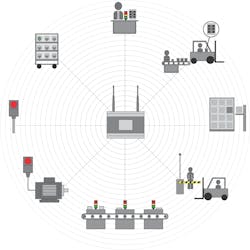The Industrial Internet of Things (or IIoT) is a key aspect of Industry 4.0—the fourth wave of innovation in the history of technology. As the trend towards smart factories grows, it is important to understand the many different terms being used, recognize how smart technologies are already being implemented in manufacturing facilities, and prepare your business for the future.
How to Define Industry 4.0, IoT, and IIoT
Industry 4.0 describes the current era in technological advancement characterized by interconnectivity that is enabled by the internet and wirelessly-connected devices. Prior to this were Industry 1.0 (water and steam power), Industry 2.0 (electric power), and Industry 3.0 (digital). Many manufacturing facilities still operate using digital technologies. While digital technologies have enabled the collection of large amounts of valuable data, this data is often not easily accessible for analysis or action.
The technologies of Industry 4.0 make data readily available while also automating the communication between industrial automation equipment and systems. This allows businesses to leverage data in more meaningful ways, including enabling remote monitoring, predictive maintenance, and Overall Equipment Effectiveness (OEE) calculations.
While Industry 4.0 refers to the historical context of these innovations, the Internet of Things (IoT) describes the technologies that connect objects to the internet. The IIoT refers specifically to the impact of this innovation on industrial applications. Together, IIoT technologies create “smart” networks. For example, a smart factory provides plant managers with visibility, analytics, and remote access to wirelessly connected machines.
IIoT technologies offer several important capabilities for factory automation, including:
Remote monitoring. Remote monitoring allows plant managers to monitor and diagnose systems quickly from any location (for example, via text or e-mail alerts). This allows users to identify and resolve problems as soon as they arise—even if an operator is away from the machine.
Predictive maintenance. Real-time data from the machines themselves also allows for more accurate planning of machine maintenance, which can help increase machine availability and reduce maintenance costs.
OEE calculations. Visibility into where and when inefficiencies occur is essential. Logged data from sensors and indicator lights installed on machines can help you calculate OEE and identify steps to improve efficiency of your machines, processes, and people.
Overall, the increased visibility, analytics, and connectedness afforded by IIoT mean that these technologies are not just an immediate solution to present challenges. Rather, these technologies enable companies to continuously improve and solve new problems as they arise—compounding the value of the investment over time.
What Does IIoT Mean for Factories?
IIoT technologies allow businesses to access and leverage factory-wide data in more meaningful ways compared to digital technologies. Following are three practical examples of how access to field device data is already helping factories increase efficiencies today.
Remote Monitoring Improves Efficiency
To ensure efficient processes throughout the factory, machine operators must quickly and easily determine the status of machines. The greater the visibility, the easier it is to identify and resolve problems and keep operations running smoothly.
Traditional tower lights indicate machine status locally—using a variety of colors and positions to signal changes in machine conditions. Most tower lights provide visibility only where they can be physically seen. However, tower lights equipped with wireless communication capabilities take visibility to the next level both by displaying a visual indication of an event and transmitting wireless alerts. This helps ensure that operational problems are identified and addressed immediately, regardless of whether the machine operator is physically present to see the visual indicator.
Wirelessly connected tower lights enable remote monitoring of machine status.
For example, tower lights with wireless communication allow operators to remotely monitor machine performance without expensive cable runs. The lights indicate machine status visually while updates are also transmitted over a secure wireless network to a remote device, triggering an action or prompting a response from an operator at a workstation away from the machine.
Predictive Maintenance Increases Machine Uptime and Availability
In addition to real-time status monitoring, IIoT technologies can also be used to help avoid machine failures thanks to predictive maintenance. This is the process of tracking the performance of crucial machine components, such as motors, to minimize downtime needed for repairs.
Traditionally, plant managers relied on preventative maintenance schedules provided by a machine’s manufacturer, including regularly replacing machine components based on a suggested timeline. However, these timelines are only estimates of when the machine will require service, and the actual use of the machine can greatly affect the reliability of these estimates.
Data from connected devices can be used to improve the efficiency of machines, processes, and people.
With predictive maintenance, much of the guesswork is removed because maintenance decisions can be made based on the historical and real-time data from the machine itself. For example, wireless vibration and temperature sensors can detect signs of misaligned, loose, or worn parts on a machine. The wireless sensors then transmit that information to a wireless controller that makes data available immediately (via text or e-mail alerts) and for long-term analysis.
By monitoring machine components in real-time for increases in vibration and temperature, problems can be detected and resolved before they become too severe, causing additional damage or resulting in unplanned downtime. Over time, the historical data creates a valuable machine performance log that can be used to make more informed maintenance decisions down the line.
OEE Calculations Enable Data-Driven Decisions
Wirelessly-connected devices (such as sensors and indicators) can also provide valuable data for OEE. This is a calculation of manufacturing process efficiency that takes into account three primary factors: availability, performance, and quality.
The availability factor takes into account events that decrease total runtime, including planned and unplanned stops. The performance factor takes into consideration anything that decreases the speed of the manufacturing process while it is running. And the quality factor accounts for parts or products that do not meet quality standards (parts that must be scrapped or reworked, resulting in wasted time).
The OEE calculation takes all of these factors into account and expresses the result as a percentage value, with 100% meaning that only good parts are manufactured (quality), as quickly as possible (performance), and without any stops (availability).
The results of this calculation provide actionable insights into the critical sources of waste in a manufacturing operation. It is therefore essential to have visibility into where and when inefficiencies or “losses” occur, so they can be remedied. Logged data from sensors and indicator lights installed on machines can help you calculate OEE and identify steps to improve efficiency of your machines, processes, and people.
Is Your Business IIoT-Ready?
From keeping machines running smoothly to helping companies make data-driven decisions, IIoT technologies provide tangible benefits for manufacturers. However, despite the many advantages, many people struggle to know where to start when moving from digital to IIoT.
Below are three questions to help you evaluate your businesses needs and prepare you to move towards IIoT solutions:
- What are the inefficiencies in your operations?
- What kind of data would help you overcome these inefficiencies?
- What communication processes need to be in place in order to utilize data in a meaningful way?
Answering these questions can help manufacturing facilities identify the best technologies to use to start taking advantage of the short- and long-term benefits of IIoT.



